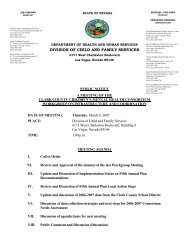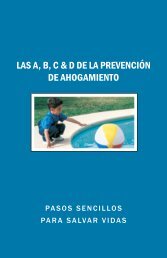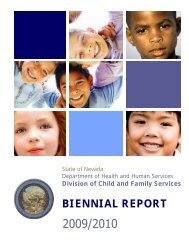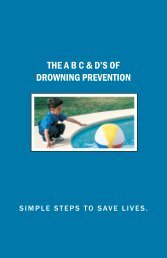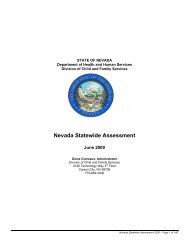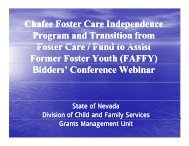STATE OF NEVADA - Division of Child and Family Services
STATE OF NEVADA - Division of Child and Family Services
STATE OF NEVADA - Division of Child and Family Services
You also want an ePaper? Increase the reach of your titles
YUMPU automatically turns print PDFs into web optimized ePapers that Google loves.
community assets to make significant changes quickly related to awareness, access <strong>and</strong> array <strong>of</strong> available services.<br />
Other potential strategies include: legislative advocacy, development <strong>of</strong> a web-based system that streamlines service<br />
provider <strong>and</strong> client information, <strong>and</strong> refinement <strong>of</strong> service provider engagement strategies. The report also includes a<br />
summary <strong>of</strong> Clark County Department <strong>of</strong> <strong>Family</strong> <strong>Services</strong> upcoming Request for Proposals for <strong>Family</strong> Preservation <strong>and</strong><br />
Support <strong>Services</strong> <strong>and</strong> Safety Team Decision Making (STDM) which has been funded through Casey <strong>Family</strong> Programs.<br />
During 2009, Washoe County initiated their service array assessment. The NRC revised their assessment process to be<br />
more closely aligned with the CFSR in early 2008 <strong>and</strong> this revised assessment process is currently under way in Washoe<br />
County Department <strong>of</strong> Social <strong>Services</strong> (WCDSS). WCDSS has opted to assess service array as related to the three Well-<br />
Being Outcomes. Once Washoe County has completed their service array process, the Rural Region will begin their<br />
process, after having observed <strong>and</strong> participated in the Washoe County process. Completion <strong>of</strong> each child welfare<br />
agency’s assessment process includes the creation <strong>of</strong> an action plan to address priority findings.<br />
Item 36: Service accessibility<br />
Goal: The State will ensure that the services in the State’s Service Array are accessible to families <strong>and</strong> children in all<br />
political jurisdictions covered in the State’s CFSP.<br />
In the 2009 Nevada CFSR, this item was rated as an area needing improvement. The state has one main objective under<br />
this item that will help it to reach the overall goal for service accessibility. This objective is that the State will refine or<br />
further develop a process to identify <strong>and</strong> assess the effectiveness <strong>of</strong> the accessibility <strong>of</strong> services for families <strong>and</strong> children<br />
across the state, including the development <strong>of</strong> statewide or agency level plans for addressing fixable barriers identified in<br />
the system. As was identified in the 2009 Nevada Statewide Assessment, funding constraints <strong>and</strong> provider<br />
retention/availability present continue to present two <strong>of</strong> the most serious barriers across the state. However, despite<br />
these challenges there continues to be ongoing efforts to increase the accessibility <strong>of</strong> services through new initiatives<br />
statewide. During 2009 <strong>and</strong> prior to the release <strong>of</strong> the most recent Title IV B, Subpart 2, Request for Proposals (RFP) in<br />
early 2010, each child welfare agency developed a list <strong>of</strong> priority service needs. Priority service needs, by agency,<br />
included:<br />
• Clark County: <strong>Family</strong> preservation services, homemaker services, substance abuse assessment <strong>and</strong> treatment,<br />
mental health assessments, medical case management, domestic violence response, <strong>and</strong> home studies <strong>and</strong> social<br />
summaries;<br />
• Washoe County: In-home family crisis stabilization services <strong>and</strong> support services, facilitators to conduct safety team<br />
meetings to facilitate timely reunification, updating home studies <strong>and</strong> social summaries, comprehensive substance<br />
abuse <strong>and</strong> mental health assessments, family counseling <strong>and</strong> substance abuse treatment, parenting groups: <strong>and</strong><br />
• Rural Region: In-home family crisis stabilization services, in-home mental health assessments <strong>and</strong> treatment,<br />
community based <strong>and</strong> in <strong>and</strong> in-home substance abuse assessment <strong>and</strong> services, community based <strong>and</strong> in-home<br />
parenting training, community based <strong>and</strong> in-home homemaker classes, <strong>and</strong> training <strong>and</strong> classes for potential adoptive<br />
families.<br />
Through Title IV B, service providers across the state are funded to provide family preservation, family support, timely<br />
reunification <strong>and</strong>/or adoption support services. Representatives from the state, Washoe, Clark <strong>and</strong> Rural child welfare<br />
participated during 2009 in the ongoing IV B workgroup established to monitor <strong>and</strong> address issues related to service<br />
provision <strong>and</strong> access. Several initiatives have seen ongoing progress over the last fiscal year. These focus on the<br />
Independent Living for Youth program in the DCFS – Rural Region, Domestic Violence, Substance Abuse, Caseworker<br />
Visitation, Differential Response <strong>and</strong> more. These programs help to ensure that services are accessible to families,<br />
despite funding constraints faced in the recent economy. These programs are described briefly below.<br />
• In late 2008, the Independent Living Program transferred funding for rural service provision to four rural <strong>Family</strong><br />
Resource Centers (FRC’s). These FRC’s are located in Elko, Pahrump, Carson City <strong>and</strong> Fallon. Each FRC agreed<br />
to provide services to youth residing in the surrounding areas to increase access to services. Since the previous<br />
CFSR <strong>Family</strong> Resource Centers, especially those in the rural counties, have built infrastructure <strong>and</strong> are also receiving<br />
additional funding <strong>and</strong> have exp<strong>and</strong>ed the array <strong>of</strong> available services. The FRC’s continued to provide these services<br />
during SFY2010.<br />
• Since the previous CFSR, Washoe County embedded a domestic violence advocate into the <strong>Child</strong> Protection Unit<br />
(CPS), through federal funding, to address domestic violence issues identified during the investigation process. The<br />
Advocate can facilitate <strong>and</strong> link victims <strong>of</strong> domestic violence who are involved with the child welfare system to<br />
Nevada APSR – SFY 2010<br />
Page 65 <strong>of</strong> 108



